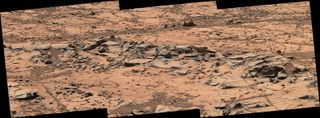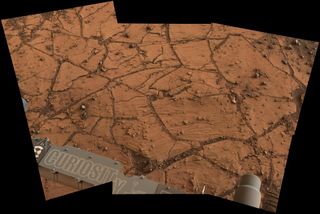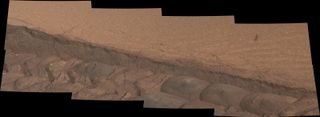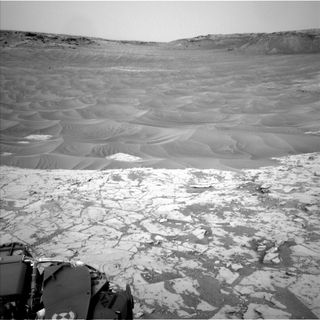
NASA's Mars rover Curiosity is taking a good, long look at the first rocks it encountered at the base of a huge Martian mountain.
The car-size Curiosity rover continues to investigate an outcrop at the foot of Mount Sharp that is dubbed Pahrump Hills, which the robot reached in September after a 14-month trek. After completing a reconnaissance circuit of Pahrump Hills, Curiosity is now examining rocks in the outcrop with its spectrometer and close-up cameras, NASA officials said.
The data Curiosity is gathering will help mission team members decide whether or not they want to drill into Pahrump Hills and collect samples again. (Curiosity already performed a full-up drilling operation in the outcrop in September, the rover's fourth since touching down on Mars.) [Curiosity Rover's Latest Mars Photos]

"We see a diversity of textures in this outcrop — some parts finely layered and fine-grained, others more blocky with erosion-resistant ledges," Curiosity deputy project scientist Ashwin Vasavada, of NASA's Jet Propulsion Laboratory in Pasadena, California, said in a mission update Tuesday (Nov. 18).
"Overlaid on that structure are compositional variations," he added. "Some of those variations were detected with our spectrometer. Others show themselves as apparent differences in cementation or as mineral veins. There's a lot to study here."

Curiosity landed inside the 96-mile-wide (154 kilometers) Gale Crater in August 2012, on a mission to determine if Mars has ever been capable of supporting microbial life. That goal has already been achieved; Curiosity's work revealed that a place near its landing site called Yellowknife Bay was a habitable lake-and-stream system billions of years ago.
The six-wheeled robot left the Yellowknife Bay area in July 2013 for Mount Sharp, which has been Curiosity's ultimate destination since before its November 2011 launch. Mission scientists want the rover to climb up through the 3.4-mile-high (5.5 km) mountain's foothills, reading in the rocks a history of Mars' changing environmental conditions as it goes.
Get the Space.com Newsletter
Breaking space news, the latest updates on rocket launches, skywatching events and more!
While Curiosity examines possible drilling targets at Pahrump Hills, the rover's handlers are also trying to troubleshoot an issue with its Chemistry and Camera instrument (ChemCam), which fires a laser at rocks and analyzes the composition of the resulting vaporized bits using a telescope and spectrometers.

A small laser that ChemCam uses to focus its telescope appears to be weakening, NASA officials said. But it may still be possible to use the instrument even if the little laser fails, they added.
"If the smaller laser has become too weak to continue using, the ChemCam team plans to test an alternative method: firing a few shots from the main laser while focusing the telescope, before performing the analysis," officials wrote in Tuesday's update. "This would take advantage of more than 2,000 autofocus sequences ChemCam has completed on Mars, providing calibration points for the new procedure."
Follow Mike Wall on Twitter @michaeldwall and Google+. Follow us @Spacedotcom, Facebook or Google+. Originally published on Space.com.
Join our Space Forums to keep talking space on the latest missions, night sky and more! And if you have a news tip, correction or comment, let us know at: community@space.com.

Michael Wall is a Senior Space Writer with Space.com and joined the team in 2010. He primarily covers exoplanets, spaceflight and military space, but has been known to dabble in the space art beat. His book about the search for alien life, "Out There," was published on Nov. 13, 2018. Before becoming a science writer, Michael worked as a herpetologist and wildlife biologist. He has a Ph.D. in evolutionary biology from the University of Sydney, Australia, a bachelor's degree from the University of Arizona, and a graduate certificate in science writing from the University of California, Santa Cruz. To find out what his latest project is, you can follow Michael on Twitter.
